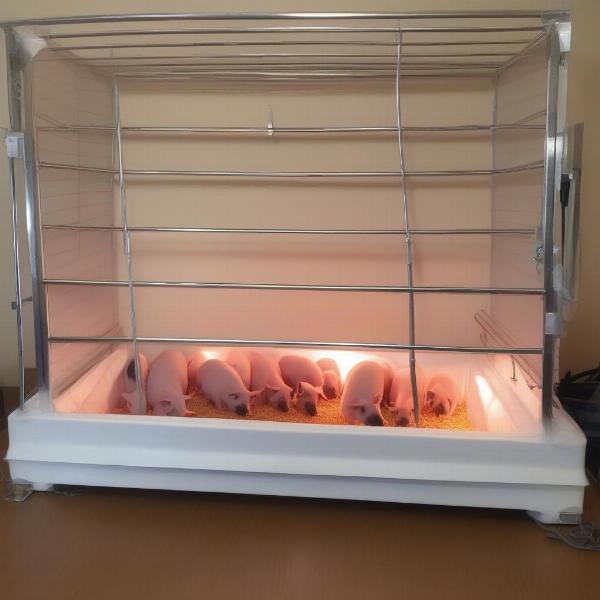A dog whelping box is more than just a container; it’s a sanctuary for a mother dog and her newborn puppies. Providing a safe and comfortable whelping box is crucial for a successful and healthy litter. Choosing the right whelping box involves considering the size of your dog, the expected litter size, and important features like easy cleaning and pig rails. This comprehensive guide will help you navigate the process of selecting, setting up, and maintaining the perfect dog whelping box for your breeding needs.
 Dog Whelping Box Setup
Dog Whelping Box Setup
Choosing the Right Dog Whelping Box
What size whelping box do I need for my dog? This is a common question among breeders. The size of the whelping box depends primarily on the size of your dog. It should be large enough for her to stretch out comfortably and turn around easily, but not so large that the puppies can wander too far from her and become chilled. Whelping boxes for large dogs require more space, while smaller breeds can manage with more compact options. Measure your dog’s length and width while lying down and add a few inches to each measurement for a comfortable fit.
Essential Features of a Whelping Box
Several key features contribute to a safe and functional whelping box. Pig rails are essential for preventing the mother from accidentally crushing her puppies against the sides of the box. These rails should be installed a few inches from the floor and walls. The box should also be easy to clean and disinfect to maintain a hygienic environment for the vulnerable newborns. Consider materials like plastic or coated wood that can be wiped down easily. Adequate ventilation is also crucial, ensuring fresh air circulation without drafts.
Setting Up the Whelping Box
Where should I place the whelping box? Ideally, the whelping box should be placed in a quiet, low-traffic area of your home where the mother dog feels secure and can be monitored easily. The temperature inside the box should be maintained at a comfortable level, especially during the first few weeks of the puppies’ lives. You can use a heating pad or lamp, ensuring they are positioned safely and cannot be reached by the mother or puppies. Soft, washable bedding should be provided, avoiding materials that could unravel or be ingested by the puppies.
Maintaining the Whelping Box
Cleanliness is paramount in a whelping box. Regularly change the bedding, removing soiled materials promptly. Disinfect the box between litters to prevent the spread of disease. As the puppies grow, you may need to adjust the height of the pig rails or transition to a larger enclosure to accommodate their increasing size and activity levels.
What are the different types of whelping boxes for dogs?
Various whelping boxes cater to different needs and preferences. You can choose from materials like wood, plastic, or even repurposed items like kiddie pools. Some whelping boxes for dogs feature collapsible designs for easy storage, while others are more permanent fixtures. Consider your budget, space limitations, and the specific needs of your breed when making your selection. dog whelping boxes provide more insights into different types available.
Expert Insights
Dr. Emily Carter, a veterinarian specializing in canine reproduction, emphasizes, “A well-designed whelping box plays a vital role in the health and wellbeing of both the mother dog and her puppies. It’s an investment that ensures a safe and comfortable start to life for the new litter.” Another expert, Jane Miller, a seasoned dog breeder, adds, “Remember, the whelping box is not just a place to give birth; it’s the puppies’ first home. Make it warm, secure, and inviting.”
Conclusion
Providing a suitable dog whelping box is a critical aspect of responsible dog breeding. By carefully considering the size, features, and placement of the whelping box, you can contribute significantly to the health and wellbeing of the mother dog and her puppies. Remember to maintain a clean and comfortable environment within the box and adjust it as needed to accommodate the growing litter. whelping boxes for large dogs are particularly important for larger breeds.
FAQ
- How do I choose the right size whelping box? Measure your dog’s length and width while lying down and add several inches to each dimension.
- What are pig rails and why are they important? Pig rails are bars installed around the interior perimeter of the box, preventing the mother from accidentally crushing her puppies.
- Where should I place the whelping box? Choose a quiet, low-traffic area where the mother feels safe and can be easily monitored.
- What type of bedding should I use? Opt for soft, washable bedding that won’t unravel or be ingested by the puppies.
- How often should I clean the whelping box? Clean the box regularly and change the bedding promptly when soiled. whelping boxes for dogs are designed for easy cleaning.
- What temperature should the whelping box be? Maintain a comfortable temperature, especially during the puppies’ first few weeks. dog whelping calculator can be helpful.
- How much does a whelping box cost? The cost varies depending on the size, materials, and features. how much does it cost to breed dogs offers further details.
ILM Dog is your trusted resource for expert advice on all aspects of dog care and breeding. We offer a wide range of information and resources, from choosing the right breed to ensuring the health and well-being of your furry friend. Whether you’re a seasoned breeder or a first-time owner, ILM Dog is here to support you every step of the way. Contact us today for expert advice on dog breeding, nutrition, training, and more. Email: [email protected], Phone: +44 20-3965-8624. Visit our website at ILM Dog for more valuable information.